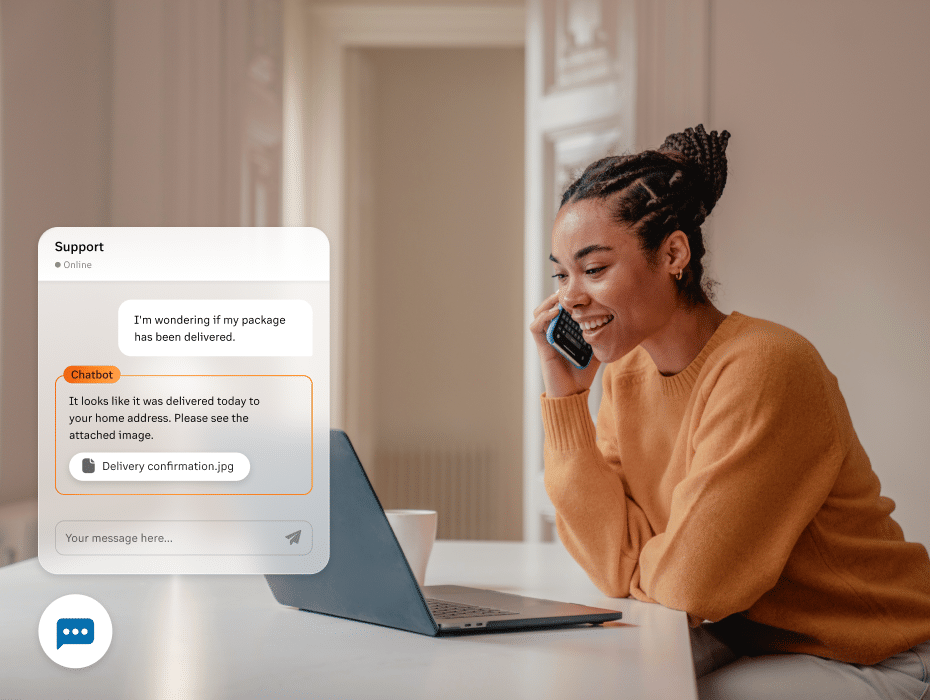Artificial intelligence (AI) is becoming part of day-to-day business life. Companies across industries are using AI for many back office activities and process automations. Conversational AI, though, can take things one step further by directly handling interactions with real people—like your customers.
The implications for providing outstanding, personalized customer experiences are obvious. But just what can conversational artificial intelligence do, how might you implement it in your business, and why may you want to.
Conversational AI: Key takeaways
- Conversational AI is artificial intelligence technology that can interact directly with real people.
- Core components of conversational artificial intelligence include natural language processing, machine learning, generative AI, and more.
- One of the richest areas for conversational AI implementation is customer service. The technology can power solutions like chatbots or appointment scheduling tools to help customers without any human intervention.
- Conversational AI in a contact center can also empower agents to provide faster, more personalized, more efficient customer support.
- By introducing conversational AI, businesses can help boost efficiency, provide better customer experiences, and reduce costs.
What is conversational AI?
Conversational AI is artificial intelligence (AI) that real people can talk to or interact with. Chatbots, virtual agents, and voice assistants are some popular examples of conversational AI today.
The most practical examples of conversational AI in the market today are voice-enabled or text-enabled “conversational assistants” for customer service. With conversational AI, customers or customer-facing employees get real-time information they’re seeking without agent intervention, or smart virtual agents that feel, respond, and sound like a human conversation, but it is really AI.
So far, so simple. However, when you throw in some similar and related terms that are often used along with conversational AI, things do get a little more complicated. Let’s clear up the differences between conversational AI and:
- Generative AI
- Chatbots and conversational AI chatbots
- Conversation intelligence.
Generative AI vs. conversational AI
Generative AI is the term used for AI algorithms that are creative—they generate something new. That might be text, images, video, audio, or even computer code. Generative AI has been in the news a lot in recent years, with the rise of solutions like ChatGPT.
While conversational AI solutions do create text or audio, it’s always in the context of a dialogue or conversation. Therefore, conversational AI can be thought of as a subset of generative AI with a narrower focus.
Conversational AI vs. generative AI in a nutshell – All conversational AI solutions are examples of generative AI, but not all generative AI is conversational AI.
Conversational AI vs. chatbots vs. conversational AI chatbots
Things get even more complex when you start talking in terms of chatbots. One of the best known applications of conversational AI is to power more modern, human-sounding chatbots. Therefore, “chatbots”, “conversational AI”, and even “conversational AI chatbots” are often used interchangeably, so what do each of those actually mean?
A chatbot is the name given to a text-based interface through which a human seeks answers from what’s essentially a machine—i.e., not another human. Not all chatbots use AI. In fact, chatbots were around before AI tech was advanced enough to be used for customer service applications. The examples that don’t use AI provide pre-programmed answers to specific questions.
Conversational AI, on the other hand, is an umbrella term for a lot of AI-powered features. It’s the superset of all AI-powered synchronous and asynchronous self-serve options (including chatbots) available to customers, AND real-time guidance, assistance and behavioral coaching options available to customer-centric employees. A conversational AI platform, therefore, offers a lot more beyond intelligent chatbots.
Finally, conversational AI chatbots are the chatbots that do leverage AI. Unlike their simpler predecessors, these conversational AI tools can carry out unscripted, natural-sounding conversations. Thanks to machine learning (more on that soon), the replies they offer can also get better over time.
Conversational AI vs. conversation intelligence
Conversational AI and conversation intelligence are two final terms that can also get confused with one another, so let’s break down the difference between them:
Conversational AI helps people in real-time by offering them voice- or text-enabled assistance. Conversation intelligence, such as AI-powered conversation analytics with CRM integration, analyzes conversations to find insights and other trends that can help improve future conversations.
Here’s an example of the two technologies working together: A virtual assistant (conversational AI) takes a call from a customer who needs help returning an item. Using voice commands, the virtual assistant is able to give the customer the information they need.
After the call, the contact center manager reviews the call insights to see how smoothly it went and how satisfied the customer was (conversation intelligence).
How conversational AI works
Conversational AI allows an AI-powered system to take a user’s input (verbal or written), process it, understand it, and generate a relevant and useful response. There are a few key components that combine so that conversational AI can do so.
Core components of conversational AI
Conversational AI brings together natural language processing (NLP), machine learning, and conversational user interfaces, enabling communication to closely resemble human engagement.
Here’s a quick refresher on each:
- NLP: The process that AI algorithms use to analyze human language and provide relevant responses. It incorporates natural language understanding (NLU) and natural language generation (NLG).
- Machine learning: The process by which AI algorithms get “smarter” or more accurate over time. By analyzing more and more data and inputs, they refine and improve their responses over time.
- Conversational user interfaces: Think voice, video, messaging and CX channels that users interact with the AI through.
Used across various business departments, Conversational AI delivers smoother customer and employee experiences with minimal need for human intervention. The magic happens only after the machines are trained thoroughly through supervised learning.
Conversational AI technologies can recognize different languages as well as intent, text, and voice semantics, message types (public or private), email metadata, and other information to deliver a seamless and smart experience for your customers and agents.
What’s more, conversational AI technologies can understand both natural speech and unexpected phrases, as well as context. Some can even show emotion and accents, to better engage with and respond to your customers.
Conversational AI for business: Two of the best conversational AI use cases
What about the practical applications of conversational AI for businesses?
The potential use cases are only going to broaden as the technology evolves, but right now, here are two key areas where conversational AI is already making an impact:
Conversational AI examples in customer service
Conversational AI can perform routine tasks, such as appointment booking, data collection, payment processing, sending medical reminders, and more. It can also automate sophisticated workflows,such as proactively reaching out to customers based on triggers and completing entire work streams.
These applications of conversational AI for small business and large can be leveraged across verticals such as:
- Banking and financial services: Chatbots can respond to simple questions about balances. In addition, advanced IVAs can automate complex work streams such as checking expenses, transferring money between accounts, providing balances, and paying bills.
- Real estate: Home buyers tend to prefer realtors who promptly answer their inquiries. Conversational AI helps ensures that customers get instant answers to their questions.
- Travel: According to a study posted by Travel Daily News, over three-quarters of Americans would lean heavily on chatbots to improve the online travel experience.
- SaaS: Users can now talk to their software instead of clicking through a series of menus or buttons to get the information they need. This can be accomplished by using voice recognition or chatbot technology.
Conversational AI examples for customer-focused employees
Conversational AI can also empower staff, such as salespeople and contact center agents, with real-time guidance and behavioral coaching. It rides along with the employee on every voice and digital interaction to provide instant tips on not just what to say, but how to say it in a way that boosts customer sentiment and drives positive business outcomes.
Multiple behavioral parameters such as active listening and empathy can be tracked to detect patterns that steer customized coaching. Conversational AI guides and coaches employees in real time across multiple use cases,including:
- Sales calls: Conversational AI buddies up with salespeople so they can have more informed discussions with prospects in order to drive conversions and revenues.
- Customer service: AI guides customer service personnel on what to say and how to say it to ensure positive customer sentiment and long-term loyalty
- Compliance: Conversational AI provides dynamic scripts and checklists to ensure that legal disclosures are shared with customers to minimize risk from lawsuits.
The benefits of conversational AI
Gartner predicts that by 2026, conversational AI will reduce contact center agent labor costs by $80 billion. It’s a critical and growing component of customer service, in particular digital self-service, which customers are increasingly adopting.
Conversational AI can be transformational in improving customer satisfaction (CSAT) scores. In a 2021 study conducted by IBM, 99% of companies reported an increase in customer satisfaction due to using conversational AI solutions like virtual agents.
The main benefits of conversational AI are:
Reduces labor and other contact center costs
Labor can represent up to 95% of contact center costs, according to Gartner. In the current economic climate, where businesses are striving to decrease expenses, conversational AI can help to cut those contact center costs, as it:
- Reduces the need for hiring with easy scalability: Virtual agents can easily be deployed during peak seasons with high traffic to help resolve customer issues without adding new employees. This can significantly lower costs as hiring new agents is never cheap.
- Increases productivity: Allows live employees to focus on higher-value activities and improve overall organizational productivity.
- Lowers training costs: Ongoing live guidance and customized behavioral coaching lowers coaching and training costs.
Increases operational efficiencies and revenue
Conversational AI has been shown to increase contact center efficiencies by improving metrics such as average speed of answer, service levels, interaction abandonment rates, customer effort scores, and customer retention rates.
Meets modern-world customer needs faster and better
Customer expectations have risen dramatically in recent years and the rules for customer engagement have changed. Conversational AI can help address these changes as follows:
- Improves brand loyalty: 86% of consumers said they would dump a brand they trusted after just two poor experiences. Conversational AI ensures fast, consistent, and smart self-service in the customer’s channel and language of choice.
- Provides smart self-serve options: Intelligent virtual assistants (IVAs) and outreach tools that can understand intent and respond to complex queries allow them to do so effectively across channels. What’s more, these sophisticated tools know what they don’t know and can cleverly route the interaction to the right agent with complete custom context including sentiment when needed.
- Offers always-on service: Reactive, company-centric models with service during “normal business hours” no longer cuts it. Customers demand 24 X 7X 365 smart service that is proactive and customer-centric.
Improves employee satisfaction across hybrid and non-hybrid work
Flexible work environments are now here to stay. Conversational AI provides time-saving and stress-busting tools to employees, irrespective of the work environment, which can help:
- Reduce manual labor: Repetitive and time-consuming tasks such as filling out forms can now be automated to improve agent experiences and productivity. This results in reduced churn and happier staff.
- Provide real-time guidance: Tools empower employees with instant knowledge and soft-skill assistance, making interactions far less stressful.
Conversational AI integration challenges to overcome
Conversational artificial intelligence is a fast-evolving area, but in many ways it’s still in its infancy. As with any relatively new technology, therefore, there are some conversational AI challenges that you need to be aware of when looking to integrate it into your operations.
One of the most notable relates to the general complexity of human language. Things like dialect phrases, idiomatic language, and sarcasm can make understanding human conversation—either verbal or textual—tough for some AI tools.
There’s also the not inconsiderable issue of privacy and security. All AI tools and algorithms must be trained on as much data as possible to achieve peak accuracy. You must, therefore, consider privacy and security concerns regarding the data used—particularly if any of it is of a personal or sensitive nature.
A final potential conversational AI risk is a perceptual one. It’s possible that your customers may not like the idea of conversing with AI rather than real people. That’s why it’s crucial to use automation and AI tools to complement your human agents, rather than ever thinking of them as replacements.
In the end, choosing the right platforms and tools is critical to achieving properly integrated conversational AI. But what do the right solutions look like?
What to look for from a conversational AI platform or solution
You’re probably not looking for conversational AI platforms per se. You want contact center or business communications platforms with conversational AI-powered features and functionality. Here’s what you need to look for from those conversational AI solutions:
- Robust AI features: The cornerstone of conversational AI tools is the artificial intelligence technology itself. Any solution you choose for your business should offer a wide range of AI-powered features, underpinned by accurate and reliable artificial intelligence. Look for things like live transcriptions, sentiment analysis, and more, to supplement more recognisable conversational AI services like chatbots and IVAs.
- Intuitive onboarding and use: Conversational AI software is undoubtedly cutting-edge, but the complexity should stay “under the hood”. When it comes to introducing your teams to a platform and to them using it day-to-day, things need to be simple. Look for software that has a shallow learning curve and which boasts intuitive, user-friendly interfaces.
- Omnichannel capabilities: As we mentioned, you’re not really looking for a conversational AI solution. More accurately, you want a contact center solution imbued with conversational artificial intelligence, and contact center platforms must have omnichannel functionality. They should make it easy for you to provide seamless customer experience across channels such as phone, live chat, email, and more. And the conversational AI technology should feed into that.
- Seamless fit with your tech stack: Your chosen platform should obviously have a comprehensive range of features. It won’t, however, be the only business tool you need to use. You should look, therefore, for software that can help you integrate conversational AI services with your existing tech stack. At the very least, ensure your chosen platform can link seamlessly with your CRM.
Get the best conversational AI assistant as part of your contact center solution
Choose RingCentral RingCX as your contact center solution, and you get conversational AI features as part of a holistic platform that has everything you need to deliver outstanding digital customer service.
Conversational AI in contact centers makes it easier to deliver the seamless experiences modern customers demand.
Intelligent virtual agents (IVAs) help you add voice and digital self-service alternatives to your omnichannel customer service offering. Customers can reach out at any time, from anywhere and know they can get the answers they need. While still being secure in the knowledge that phone, email, live chat, and other channels are there if they need them, too.
Talk to a RingCentral expert today, to learn more.
Conversational AI FAQs
Why is conversational AI important to customers?
Conversational AI can help businesses to deliver faster, more accessible, and more efficient customer experiences. It can power chatbots to converse naturally with customers and give them the answers they need. Or, it can offer real-time guidance and tips to contact center agents, to help them to better serve their customers.
Why conversational AI for your business?
As well as improving customer experience, conversational AI tools can also offer further significant benefits to your business. By handling some of the simplest customer queries and helping agents with others, conversational AI tools make contact centers more productive, which in turn makes them more cost-effective.
What is conversation intelligence?
Conversation intelligence refers to technology which analyzes conversations to uncover patterns, insights, and information. It’s related to conversational AI, but not the same thing. Used in combination, however, the two technologies can help businesses deliver even better customer experiences.
How do you create conversational AI solutions?
The easiest way to get the benefits of conversational AI is to invest in a tool like RingCentral RingCX which has AI features built-in. If you did choose to build your own solution, you need to do things like collecting data on frequently asked customer questions, training AI algorithms on that data, and more.
Updated Sep 15, 2025
















